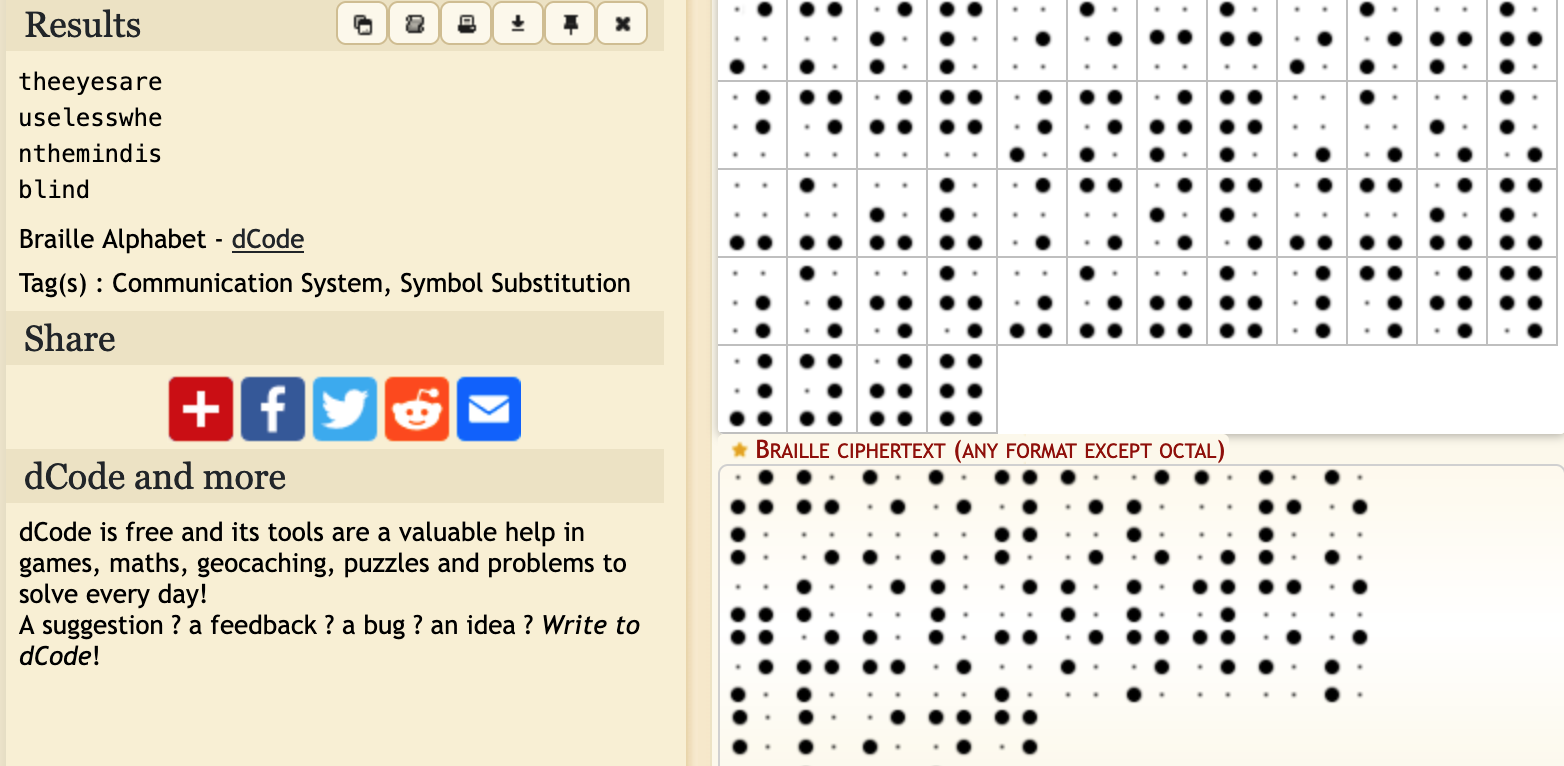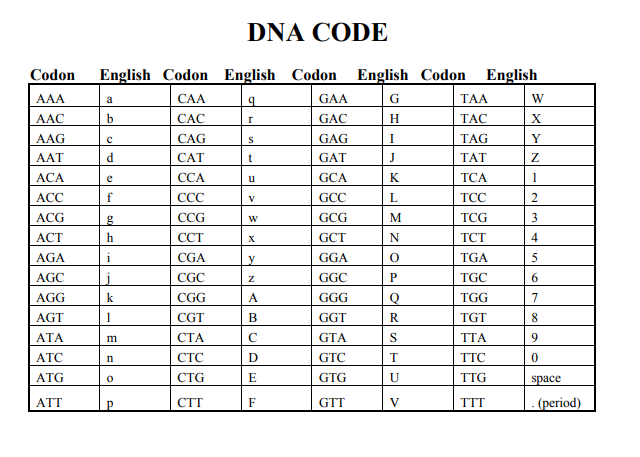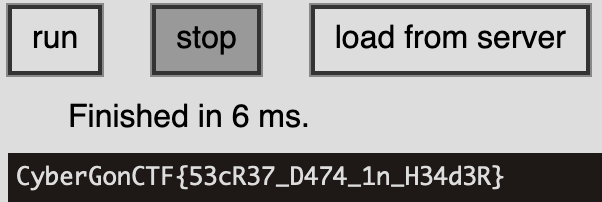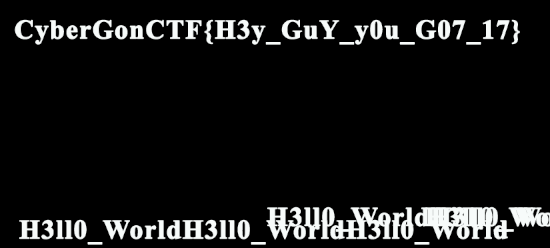This was an interesting CTF hosted by a Myanmar-based cybersec firm. My team was placed 5th in this CTF.

Solves
Dots
We are given an image with dots. Using Dcode, we can see that it is a representation of the Braille symbols.
 Using the site to decode the symbols gives us the flag.
Flag:
Using the site to decode the symbols gives us the flag.
Flag: CybergonCTF{the_eyes_are_useless_when_the_mind_is_blind}
Game
% echo "enolaerauoynehwyrramydoolbyalptonod" | rev
donotplaybloodymarrywhenyouarealone
Now you see me 1
Given: A file with whitespaces (space, tab, CR and LF)
% cat Now_You_See_Me.txt | tr ' \t' '01' | sed -e 's/^00//g' | sed -e 's/^000/0/g' | egrep -e ".{8}" | tr -d '\r\n' | perl -lpe '$_=pack"B*",$_'
Congratulations this is for you !!
CybergonCTF{Always_Look_Beyond_What_You_Can_See}
Steps:
- Replace
<space>with0and<tab>with1 - Trim leading zeros in each line, so that there is only one
0at the beginning of the line - Treat this as a binary string and convert to ASCII.
Captured
Our intels captured some conversation between Mr.Yit and his friend. Do you find some useful information ?
This audio file has some audio, with a phone number that is in DTMF. As can be seen in the spectrogram below, the signal consists of two frequencies (Dual Tone Multiple Frequencies) and yields the numbers 09007007007, which happens to be the flag.

Help Me
How many languages can you speak ?
We are given a video file that has 3 short flashes, 3 long flashes, followed by 3 short flashes again. This whole sequence is repeated two more times. This is a well known representation of SOS in morse code. So the flag is just CyberGonCTF{SOS_SOS_SOS}
All in One
We are given the following ciphertext, along with an image
3n5g1jgAx0w{Bt@WPbH_9bm!mIgZ2aI}
9!SyZka>@a8[;B%tDySLX#bCV{nT+ZJYIS2;kD6]FDweC9%S9]R'*n[dV:Vz(kJ9>80r=31!E_a.@IOT3]F&mp+cP:9E!
yD7g,WeYM%9/U^!q_kf+/[N1s!2tBNfL/bKOc)]A
Recognizing that the image contains symbols from the Wakanda language, used Dcode to decode it:

This yields the following plaintext.
ThisIsTheKey
B14cKP4n7h3R
At this point, I was stuck and could not figure out how to apply the key. It was 24-bytes long, 12 in each line. I tried various combinations of AES, but was not able to solve the cipher.
After the CTF was complete, I learned that it is the Vigenere cipher with B14cKP4n7h3R as the key, with A-Za-z0-9!@ as the alphabets. I modified a python implementation to cement my understanding of the Vigenere cipher.
import string
# borrowed from https://gist.github.com/dssstr/aedbb5e9f2185f366c6d6b50fad3e4a4
def vigenere(
text: str,
key: str,
alphabet=string.ascii_lowercase + string.ascii_uppercase + string.digits + "!@" ,
encrypt=True):
result = ''
ki = 0 # need a separate index for the Key to prevent it being incremented if we encounter a strange character that is not in the alphabet
for i in range(len(text)):
if (text[i] in alphabet):
letter_n = alphabet.index(text[i])
key_n = alphabet.index(key[ki % len(key)])
if encrypt:
value = (letter_n + key_n) % len(alphabet)
else:
value = (letter_n - key_n) % len(alphabet)
# print(f"[{letter_n:2d} - {key_n:2d}] %{len(alphabet):2d} = {value:2d} : {alphabet[letter_n]} {key[i % len(key)]} --> {alphabet[value]}")
result += alphabet[value]
ki += 1
else:
print(f"{text[i]} not found in the alphabet ... passing it through as-is")
result += text[i]
return result
def vigenere_encrypt(text, key):
return vigenere(text=text, key=key, encrypt=True)
def vigenere_decrypt(text, key):
return vigenere(text=text, key=key, encrypt=False)
text = '3n5g1jgAx0w{Bt@WPbH_9bm!mIgZ2aI}'
key = "B14cKP4n7h3R"
print(vigenere_decrypt(text, key))
# CyberGonCTF{W4k4ND4_f0r3v3R!!!!}
EZ-RSA
We are given the following source for the challenge, with my annotation:
flag = open("flag.txt").read()
m = bytes_to_long(flag.encode())
p = getStrongPrime(512) # strong p and q
q = getStrongPrime(512)
n = p*q
e = 0x10001 # large e
c = pow(m,e,n) # standard RSA
num = randint(100,999) # random number
p_encode = []
q_encode = []
p_list = re.findall('.',str(p)) # gets each character of stringified p and q ... so the character of each digit ... '0' to '9'
q_list = re.findall('.',str(q))
# each digit of p and q are XOR'd with the random number and turned back into a string and provided to us.
for value in range(len(p_list)):
p_encode.append(str(int(p_list[value]) ^ num))
q_encode.append(str(int(q_list[value]) ^ num))
# we are given c, n, encoded p and q, (and e)
print(c)
print(n)
print(p_encode)
print(q_encode)
Since we have a small search space for the random number, we can bruteforce the search in [100 - 999] to see which values yield values between ord('0') and ord('9'), with the consraints that the contents of p and q should only be digits. Once we determine num, we can reverse-engineer p and q and decode the cipher.
The solution is as follows:
# we are given c, n, and encoded values of p and q
# Bruteforce the original random number used
possible_nums = []
for i in range(100, 999):
if (all(x >= ord('0') and x <= ord('9') for x in [int(pval) ^ i for pval in set(p)] )):
if (all(x >= ord('0') and x <= ord('9') for x in [int(qval) ^ i for qval in set(q)] )):
possible_nums.append(i)
print(f"{len(possible_nums)} possible values found. Trying each one.")
for num in possible_nums:
fac_p = ''.join([chr(int(x)^num) for x in p])
fac_p = int(fac_p)
e = 0x10001
if (n% fac_p == 0):
fac_q = n // fac_p
phi = (fac_p-1)*(fac_q-1)
d = inverse(e, phi)
m = pow(c, d, n)
print(f"{num}: {long_to_bytes(m).decode()}")
# 563: CyberGonCTF{345y_p34sy_R54_c1ph3R}
dO nOT aCCESS
We are given a hexavue cipher based image, which translates to the following text
ACTTCGTAGT
TGCGATTCCC
ATTGGAATTC
TGGTTGCTCG
CTTCTTTGAA
Row-wise reading order : ACTTCGTAGTTGCGATTCCCATTGGAATTCTGGTTGCTCGCTTCTTTGAA
Column-wise reading order : ATATCCGTGTTCTGTTGGTCCAGTTGTAGTTTACTACTTGGCTCATCCGA
The encoding uses the following scheme to translate a letter into a DNA codon-triplet.

Reversing the encoding is pretty straight-forward lookup.
import string
import itertools
decoder = string.ascii_lowercase + string.ascii_uppercase + string.digits[1:]+ string.digits[0] + ' .'
decoder_dict = {}
for i, key in enumerate(itertools.product('ACGT', repeat=3)):
decoder_dict[''.join(key)] = decoder[i]
# ROW and COL reading orders
for STR in ["ACTTCGTAGTTGCGATTCCCATTGGAATTCTGGTTGCTCGCTTCTTTGAA", "ATATCCGTGTTCTGTTGGTCCAGTTGTAGTTTACTACTTGGCTCATCCGA"]:
flag = ""
for i in range(3,len(STR),3):
flag += decoder_dict[STR[i-3:i]]
print(f"{STR} ===> {flag}")
#ACTTCGTAGTTGCGATTCCCATTGGAATTCTGGTTGCTCGCTTCTTTGAA ===> h3Y y0u G07 DN4 <--- correct flag
#ATATCCGTGTTCTGTTGGTCCAGTTGTAGTTTACTACTTGGCTCATCCGA ===> m2U0872l8l9CFP12
Hide and Seek
We are given a MS Word document file in .docx format. Knowing that .docx is zipped XML, we can unzip the files, first.
% unzip -l Secret_File.docx
Archive: Secret_File.docx
Length Date Time Name
--------- ---------- ----- ----
1704 01-01-1980 00:00 [Content_Types].xml
590 01-01-1980 00:00 _rels/.rels
9252 01-01-1980 00:00 word/document.xml
1209 01-01-1980 00:00 word/_rels/document.xml.rels
3021 01-01-1980 00:00 word/footnotes.xml
3015 01-01-1980 00:00 word/endnotes.xml
8390 01-01-1980 00:00 word/header1.xml
8393 01-01-1980 00:00 word/theme/theme1.xml
3724 01-01-1980 00:00 word/settings.xml
31761 01-01-1980 00:00 word/styles.xml
894 01-01-1980 00:00 word/webSettings.xml
1919 01-01-1980 00:00 word/fontTable.xml
747 01-01-1980 00:00 docProps/core.xml
984 01-01-1980 00:00 docProps/app.xml
--------- -------
75603 14 files
Extracting the archive and checking each file for suspicious content, showed the following content in word/header1.xml.
++++++++++[>+>+++>+++++++>++++++++++<<<<-]>>>---.>+++++++++++++++++++++.-----------------------. +++.+++++++++++++.<++++.>---.-.<----.+++++++++++++++++.--------------.>+++++++++++++.<---------- -------.--.>------------------------.-----------------.<.++++.>+++++++++++++.<+++++++++++++.---- ------------.+++.---.>.<---.>+++++++++++++++.---------------.<+++++++++++++++++++++++.<+++++++++ ++++++++++++.+.>>+++++.<<-.>++++++++++.>+++++++++++++++++++++++++.
Knowing that this is Brainfuck language, I fed the string into a online interpreter to get the flag.

Data Exfiltration
We are given a file with PNG extension, which looks to be malformed and does not open. Viewing the file in an hex editor shows that the file has none of the expected fields from a PNG file. The content has many strings that reference Adobe and Layers. Also, it shows that the tool used to create the file is Adobe Photoshop.
<xmp:CreatorTool>Adobe Photoshop CS6 (Windows)</xmp:CreatorTool>
So, I guessed it might be a photoshop image file. Looking for the fileformat of the Photoshop image file, showed that except for the first 4 bytes, the image follows the Adobe 8BPS file format exactly. So, changing the magic bytes of the file and opening it GIMP showed the flag in one of the layers of the image.
The file header contains the basic properties of the image.
| File Data | Length | Description in the Standard |
|---|---|---|
8950 4e47 | 4 | Signature: always equal to ‘8BPS’ . Do not try to read the file if the signature does not match this value. |
0001 | 2 | Version: always equal to 1. Do not try to read the file if the version does not match this value. (PSB version is 2.) |
0000 0000 0000 | 6 | Reserved: must be zero. |
0003 | 2 | The number of channels in the image, including any alpha channels. Supported range is 1 to 56. |
0000 05dc | 4 | The height of the image in pixels. Supported range is 1 to 30,000.(PSB max of 300,000.) |
0000 05dc | 4 | The width of the image in pixels. Supported range is 1 to 30,000.(PSB max of 300,000) |
0008 | 2 | Depth: the number of bits per channel. Supported values are 1, 8, 16 and 32. |
0003 | 2 | The color mode of the file. Supported values are: Bitmap = 0; Grayscale = 1; Indexed = 2; RGB = 3; CMYK = 4; Multichannel = 7; Duotone = 8; Lab = 9. |
So, we can deduce that the file is a PSD file and we change the first four bytes (magic bytes) to be 3842 5053, which is 8BPS. We also change the file extension to be .psd and open the file in Photoshop or Gimp.
One of the layers of the image has the flag.

Catch me if you can
We are given a file with .gif extension. But it would not open and seems to have bad magic bytes. Looking into it further, we can see that the magic byte of the given file is 9a instead of the traditional GIF89a. So, we fix the gif file by inserting the characters GIF8 at the beginning. The new file correctly identifies as a 500 x 500 GIF file and shows the flag when opened.
% file Stegano1.gif
Stegano1.gif: data
% xxd Stegano1.gif | head -1
00000000: 3961 f401 f401 f700 0003 0303 7f81 8092 9a..............
% echo -n GIF8 > fixed.gif; cat Stegano1.gif >> fixed.gif
% file fixed.gif
fixed.gif: GIF image data, version 89a, 500 x 500
% xxd fixed.gif| head -1
00000000: 4749 4638 3961 f401 f401 f700 0003 0303 GIF89a..........
8Cel
For this forensics challenge, we are given a zip file called 8cel.zip. Looking through the contents, we can see that it is a XLSX format MS Office Excel workbook. Exploring the workbook, we find that Sheet 2 has a set of 175 EMBED formula with base64 encoded strings. Extracting these 175 strings and decoding them shows several fake flags and ONE actual flag. While I solved this problem manually, the following series of bash commands shows the steps in solving this chall.
% unzip -c 8cel.zip xl/worksheets/sheet2.xml | sed -e 's/</\n</g' | grep EMBED | cut -d, -f2 | tr -d '\")' | python3 -m base64 -d | sed -e 's/}C/}\nC/g' | grep -v F14
CyberGonCTF{y0u_G07_7h3_53cR37_1Nf0}
Frozen Xip
This file is something wrong. Can you open it before the winter season?
We are given a file called xipper.PNG

- The magic bytes should be
504B0304instead of504B0403 - The byte at the offset 0x1A should be
0x08instead of0x14. This represents the length of the file nameflag.txt
Doing these two changes will fix the zip file header and allows us to extract the file, which contains a line from Robert Frost’s poem:
% xxd -c 50 flag.txt
00000000: 5468 6520 776f 6f64 7320 6172 6520 6c6f 7665 6c79 2c20 6461 726b 2061 6e64 2064 6565 7020 2f20 4275 7420 4920 6861 7665 2070 The woods are lovely, dark and deep / But I have p
00000032: 726f 6d69 7365 7320 746f 206b 6565 7020 2f20 416e 6420 6d69 6c65 7320 746f 2067 6f20 6265 666f 7265 2049 2073 6c65 6570 2e0a romises to keep / And miles to go before I sleep..
00000064: e280 9420 526f 6265 7274 2046 726f 7374 2c20 e280 9c53 746f 7070 696e 6720 4279 2057 6f6f 6473 206f 6e20 6120 536e 6f77 7920 ... Robert Frost, ...Stopping By Woods on a Snowy
00000096: 4576 656e 696e 6722 0920 2020 2020 0920 0a20 2020 2020 2009 2009 0920 2020 2009 2020 2020 0920 2020 0920 2020 2020 2009 2020 Evening". . . . .. . . . .
000000c8: 0920 2020 2020 0920 0a09 2020 2020 0920 0920 2020 2009 2020 2020 2009 2009 2020 2020 2020 0920 2020 2020 0920 2020 2020 2009 . . .. . . . . . . . .
000000fa: 200a 2020 0920 0920 2020 2020 0920 2009 2020 2020 2020 0920 2020 0909 2020 0920 2020 2020 2009 2020 2020 200a 2020 2020 2020 . . . . . . .. . . .
0000012c: 2009 2020 0920 2009 2020 2020 2020 2009 0920 2020 2020 2009 0920 2009 2020 0920 2020 2020 0a20 2020 2020 2009 2020 0920 2020 . . . .. .. . . . . .
0000015e: 2020 2009 2020 2020 2009 2020 2020 2020 0920 2020 2020 2020 0920 2020 0909 2020 2020 2009 2020 2020 0a20 0920 2020 2020 2009 . . . . .. . . . .
00000190: 2020 0920 2020 2020 2009 2020 2020 2020 0920 2020 2020 2009 2020 2020 2020 2009 2020 2009 2020 0920 2020 2020 2020 0a20 2020 . . . . . . . .
000001c2: 2020 0920 2020 0920 0920 2020 2020 0920 2020 2009 2020 2020 0920 2009 2020 2020 2009 2020 2020 2009 200a 0920 2009 2020 2020 . . . . . . . . . .. .
000001f4: 2020 2009 2020 2020 2009 2020 2009 2020 2020 0920 2020 2009 0920 2009 2020 200a 2020 2020 0909 2009 2020 2020 2020 2009 2020 . . . . .. . . .. . .
00000226: 2020 2020 0920 2020 2020 0a
The ample number of whitespaces, along with name, description of the challenge, alludes to Snow - a whitespace steganography tool. Simply feeding the text file to snow gives us the flag.
% snow -C flag.txt
CyberGonCTF{Z1pp3R_4nD_573G5n0W}
Resources, Writeups
- OSInt enumeration : https://whatsmyname.app/
- https://www.spammimic.com/decode.shtml
- https://copy.sh/brainfuck/
- https://www.youtube.com/watch?v=sZAVLJTHtj4
- Sloppy Joe Pirates: https://www.youtube.com/watch?v=bFAElPXPB4w
- https://learn-cyber.net/writeup/What-Is-It
- https://learn-cyber.net/writeup/Super-Secure-Encryption
- https://learn-cyber.net/writeup/Old-Obfuscation
- https://learn-cyber.net/writeup/Hollywood
- https://users.cs.jmu.edu/buchhofp/forensics/formats/pkzip.html
Challenges
Category Challenge Description CRYPTO All in One Vigenere with Wakanda text cipher CRYPTO Dots Braille to text CRYPTO EZ RSA crack substitution cipher for p & q CRYPTO Game CRYPTO Now You See Me 1 CRYPTO Now You See Me 2 CRYPTO Warm Up 1 CRYPTO Warm Up 2 CRYPTO dO nOT aCCESS Hexavue -> DNA codon triplets -> text FORENSICS 8cel Excel formula -> base64 FORENSICS Device Info (ep1) FORENSICS Device Info (ep2) FORENSICS Frozen Xip malformed zip -> SNOW whitespace steg FORENSICS Hide and Seek FORENSICS Malfunctioning File IR Basic - 1 IR Bonus IR Try Hard IR Victim Info MISC BMW for Sale MISC Back Door MISC Captured MISC Discord MISC Feedback MISC Find Me MISC Help Me MISC Memory MISC Move Move MISC Operation Ghost MISC Storm Zero Five Five Eight MISC Wallet Address OSINT Arrival OSINT Big Fan 1 OSINT Big Fan 2 OSINT Big Fan 3 OSINT Channel OSINT Country OSINT Let`s Track Him OSINT Singer OSINT This is not the end ;) OSINT Time To Rest OSINT Warm Up 1 OSINT Where Is His Next Point ? PWN Tour PWN autograph PWN notebook PWN really random printf vulnerability PWN teeny SIGROP STEGANO Catch Me If You Can STEGANO Data Exfiltration malformed PSD -> layers STEGANO Warm Up 1 STEGANO Your Favorite MTV STEGANO Your_Craziest_Song WEB Cybergon’s Blog WEB Do you believe in Luck WEB Flappy block v2 WEB Love is Blurry reversing Hollywood reversing Mad Genius reversing Old Obfuscation reversing Super Secure Encryption reversing What is it
